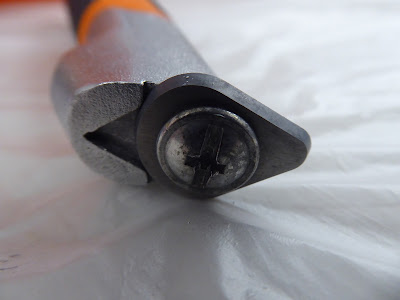It was time to flip the boat upright again, for the fourth time. Let the gods smile upon us and make it the last time...
In readiness for the great day I removed the polythene sheeting which had protected the lower hull while I paint-stripped the upper side panels.
This what it looked like, covered up.
And this what it looked like uncovered, in the early evening spring sunshine.
There were a few tasks to complete before turning her right side up. One very important one was to make sure that the centreboard pendant was pulled in completely and cleated off.
Examination of the pendant through the centreboard inspection ports revealed that it was loosely coiled inside the case, like this.
You can't see the pendant but trust me, it was loose.
However, hauling on the pendant from the footwell did not budge it an inch. It was firmly held in place inside the case, meaning that the heavy centreboard was trapping it.
So I climbed on top of the hull and raised the board with the long nosed pliers faced with foam padding that I used to raise it when installing the board itself. This is them.
It was easy to raise the board a few inches while Mrs Boatbuilder pulled the pendant through and tightened it. She retrieved about two feet of rope which would have allowed the board to drop down out of the keel when the boat was turned over, which would have been a big problem.
Another task was to reassemble the build cradle with its spreaders.
All was ready.
We gathered up a big team of friends and family to make the flip which was scheduled for Saturday 3rd May at 5pm.
We had six helpers on each side of the boat, which previous experience told us would be ample.
The driveway had been covered with old rugs from inside the house to prevent damage from the gravel.
I directed operations, having the team carry the boat out onto the carpet and move sideways several feet.
They then lowered the port side to the ground and carefully rolled it over until upright.
So far so good. All was well.
We moved the cradle back inside the garage and applied the brakes to stop it from moving.
The team then carried the upright boat back into the garage and lowered it into the cradle, lining it up with two bits of blue tape to indicate its correct position.
I was too busy to take any pics but Mrs Boatbuilder shot a video, which I will upload when I figure out how.
But the video does show that the whole thing took precisely 6 minutes and 49 seconds, and went perfectly.
Here she is the following day, ready for the final phase of repainting.
What a great sense of achievement!
Huge thanks to each and every one of the team, who then happily devoured lots of beer and home made pizza and brownies.
Fantastic day!

















































